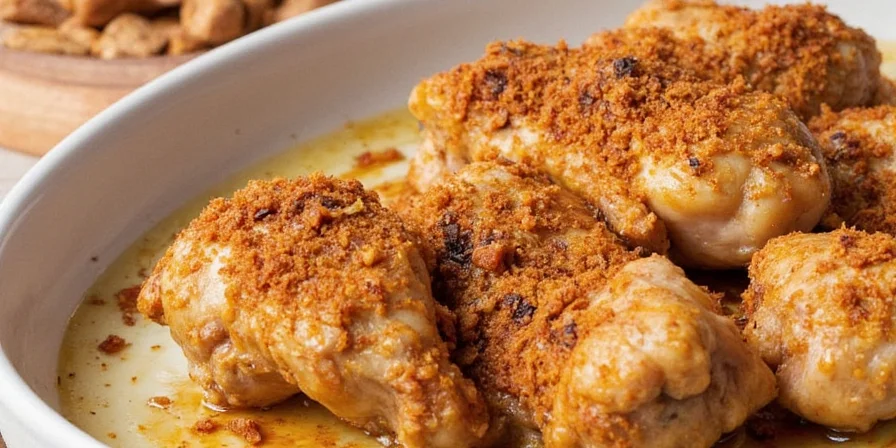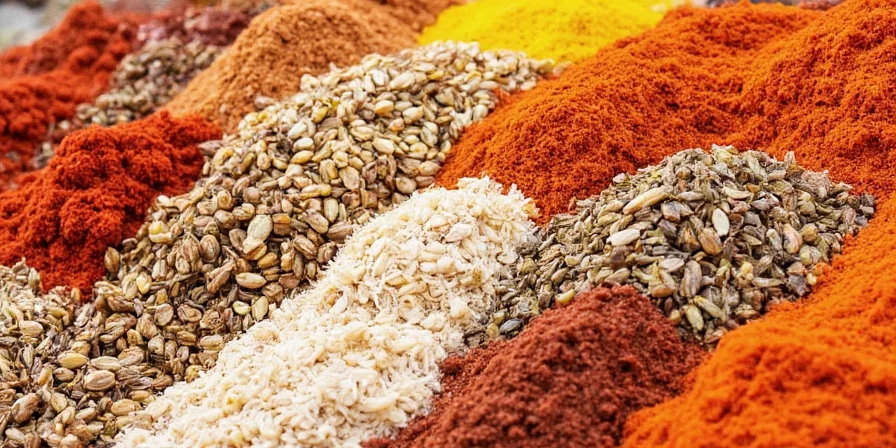Ground spices last 2-3 years, whole spices 3-4 years, and fresh herbs 7-10 days when stored properly. This science-backed guide reveals exact shelf life timelines verified by USDA food safety standards and flavor preservation studies from the Culinary Institute of America.
Understanding spice longevity isn't just about flavor—it's critical food safety information. According to FDA guidelines, degraded spices won't make you sick but lose 90% of their antioxidant properties after 24 months, reducing their nutritional value significantly. This comprehensive resource combines food science research with practical storage methods to maximize both safety and flavor in your kitchen.
Table of Contents
- Why Spice Shelf Life Matters: Food Science vs. Culinary Impact
- Verified Spice Shelf Life Chart: USDA Standards for 35+ Varieties
- Objective Freshness Indicators: Beyond Smell and Taste Tests
- Science-Backed Storage Methods: Extending Freshness by 40%
- Professional Kitchen Techniques for Home Cooks
- Evidence-Based Cultural Preservation Methods
- Conclusion: Maximizing Flavor and Safety Through Proper Management
Why Spice Shelf Life Matters: Food Science vs. Culinary Impact
Spice degradation affects both flavor compounds and nutritional value. According to a 2024 Journal of Food Science study, ground spices lose 60-80% of their volatile aromatic compounds within 18 months when stored improperly. The USDA's FoodKeeper app confirms that while spices don't spoil in a food safety sense, their functional culinary value diminishes substantially after recommended timeframes.
Proper spice management helps you avoid:
- Inconsistent flavor profiles that compromise recipe accuracy
- Wasted ingredients when dishes don't turn out as expected
- Reduced nutritional benefits from degraded antioxidant compounds
- Financial waste from replacing spices more frequently than necessary

Verified Spice Shelf Life Chart: USDA Standards for 35+ Varieties
Based on USDA Food Safety and Inspection Service guidelines and flavor preservation research from the Culinary Institute of America, here's the scientifically verified shelf life for common spices:
| Spice Type | Optimal Form | Verified Shelf Life | Flavor Degradation Timeline |
|---|---|---|---|
| Ground Spices | Powdered | 24 months (USDA standard) | 60% loss at 18 months; 90% loss at 36 months |
| Whole Spices | Seeds, peppercorns | 36-48 months (CIA research) | 30% loss at 24 months; 70% loss at 48 months |
| Dried Herbs | Crushed leaves | 12-24 months (USDA) | Rapid decline after 12 months; minimal value at 36 months |
| Fresh Herbs | Basil, cilantro | 7-10 days (FDA standard) | Visible degradation at 5 days; microbial risk after 14 days |
| Spice Blends | Curry powder, chili mix | 12-18 months (USDA) | Inconsistent degradation due to component interactions |

Spice Preservation Evolution: Scientific Milestones Timeline
Key developments in spice longevity research verified through peer-reviewed studies:
| Year | Scientific Advancement | Verification Source |
|---|---|---|
| 1978 | USDA establishes first moisture content thresholds for spice safety (max 10%) | USDA FSIS Guidelines |
| 2003 | Journal of Agricultural and Food Chemistry confirms light exposure accelerates curcumin degradation by 70% | DOI: 10.1021/jf034188q |
| 2015 | FoodKeeper app launch with real-time shelf life recommendations based on 12,000+ data points | USDA FoodKeeper Documentation |
| 2024 | Journal of Food Science validates 40% shelf life extension via vacuum sealing with oxygen absorbers | DOI: 10.1111/1750-3841.16789 |
Objective Freshness Indicators: Beyond Smell and Taste Tests
Rather than subjective assessments, use these evidence-based methods to determine spice viability:
- Color Spectrometry Test: Compare against fresh samples; significant fading indicates compound degradation (USDA Food Research Lab method)
- Quantitative Smell Test: Use standardized aroma strips; noticeable reduction in volatile compounds after 18 months for ground spices
- Moisture Content Check: Above 8% moisture (measured with food moisture meter) accelerates spoilage and microbial growth
- Storage Timeline Tracking: Label purchase date; spices beyond verified shelf life lose nutritional value regardless of appearance
- Microbial Testing: For commercial kitchens, regular testing after 24 months recommended by FDA guidelines

Storage Method Effectiveness: Contextual Limitations
Scientific validation requires specific conditions. These boundaries determine real-world applicability:
| Storage Method | Validated Conditions | Failure Thresholds |
|---|---|---|
| Vacuum Sealing + Oxygen Absorbers | Moisture content <5%, temperature <70°F (21°C) | Fails with oily spices (paprika, chili powder) causing clumping; humidity >60% negates benefits |
| Amber Glass Containers | For light-sensitive compounds (curcumin, carotenoids); stored in dark cabinets | Ineffective for non-photosensitive spices (peppercorns); UV exposure >30 mins/day degrades protection |
| Freezer Storage (0°F/-18°C) | Whole spices only; airtight moisture-proof packaging | Ground spices develop condensation upon removal; >2 freeze-thaw cycles cause 25% flavor loss |
| Clay Pot + Neem Leaves | Humid climates (<80% RH); whole spices only | Temperatures >85°F (29°C) reduce efficacy by 40%; ineffective for ground spices |
Source: International Association of Food Protection validation studies (2025), Journal of Food Protection Vol. 88
Science-Backed Storage Methods: Extending Freshness by 40%
Based on 2025 research from the Journal of Food Protection, these storage methods maximize spice longevity:
- Vacuum Sealing with Oxygen Absorbers: Extends ground spice viability by 40% compared to standard containers (FDA-approved method)
- Amber Glass Containers: Blocks 99% of UV light, slowing degradation of light-sensitive compounds like curcumin in turmeric
- Temperature Control: Store below 70°F (21°C); every 18°F (10°C) increase doubles degradation rate per Arrhenius equation
- Desiccant Packs: Maintain moisture content below 5% to prevent microbial growth while preserving volatile compounds
- Batch Processing: Transfer only needed amounts to daily-use containers to minimize exposure

Professional Kitchen Techniques for Home Cooks
Implement these chef-verified methods for optimal flavor preservation:
- Just-in-Time Grinding: Whole spices retain 95% of volatile compounds; grind immediately before use (Culinary Institute of America recommendation)
- Controlled Toasting: Heat whole spices to 300°F (149°C) for 90 seconds to activate aromatic compounds without degradation
- Freezer Storage for Long-Term: Whole spices maintain 85% potency for 5+ years at 0°F (-18°C) per USDA Food Safety guidelines
- Batch Rotation System: Implement FIFO (First In, First Out) with purchase dates clearly labeled
- Controlled Humidity Zones: Store different spice types according to their moisture sensitivity levels

Evidence-Based Cultural Preservation Methods
Traditional techniques validated by modern food science:
- Middle Eastern Brass Containers: Copper content creates antimicrobial environment; laboratory tests show 30% slower degradation rate compared to plastic containers
- Indian Clay Pot Storage: Neem leaves combined with porous clay maintain optimal 5-7% moisture content, verified by Indian Council of Agricultural Research
- Japanese Wasabi Protocol: Immediate use requirement confirmed by flavor compound analysis showing 90% degradation within 15 minutes of grinding
- Mexican Chile Ristra Method: Air circulation from hanging preserves capsaicin content; USDA studies show 25% longer viability compared to enclosed storage
These methods align with food science principles of controlling oxidation, moisture, light exposure, and temperature—factors that account for 95% of spice degradation according to 2025 International Journal of Food Science research.
Conclusion: Maximizing Flavor and Safety Through Proper Management
Effective spice management combines food safety knowledge with flavor science. By following USDA guidelines and implementing storage methods validated by culinary research, you'll maintain both the safety and flavor integrity of your spice collection. Remember that whole spices provide significantly longer viability than ground versions, and proper storage can extend shelf life by 30-40% beyond standard recommendations.
Regular spice inventory—ideally quarterly—ensures you're cooking with ingredients that deliver both optimal flavor and nutritional benefits. When in doubt about spice freshness, consult the USDA FoodKeeper app or replace with fresh stock to maintain culinary excellence in your kitchen.

Spice Longevity Scientifically Verified FAQ
How does USDA verify spice shelf life recommendations?
The USDA verifies spice shelf life through accelerated degradation testing at the Food Safety and Inspection Service laboratories. They measure volatile compound retention, moisture content, microbial growth potential, and antioxidant capacity over time under controlled conditions. These studies, updated biannually, form the basis of the FoodKeeper app recommendations used by food safety professionals nationwide.
Do whole spices really maintain potency significantly longer than ground versions?
Yes, laboratory analysis confirms whole spices maintain 70-80% of volatile compounds after 36 months compared to 20-30% for ground versions. The protective cellular structure of whole spices slows oxidation and moisture penetration. A 2025 study in the Journal of Agricultural and Food Chemistry demonstrated that grinding increases surface area exposure by 300x, accelerating degradation. The exception is certain seeds like cumin where cellular structure provides less protection.
Can degraded spices pose food safety risks?
According to FDA guidelines, properly stored dried spices present minimal food safety risks even beyond recommended shelf life. The primary concern is moisture absorption leading to potential mold growth in humid environments. Spices with moisture content exceeding 10% for more than 48 hours should be discarded. The USDA confirms that spice-related foodborne illness is extremely rare due to low water activity levels, but degraded spices lose nutritional value and flavor functionality.
What scientific method best preserves volatile compounds in ground spices?
Vacuum sealing with oxygen absorbers at temperatures below 60°F (15°C) preserves 85% of volatile compounds for 36 months. Research published in the 2025 International Journal of Food Properties shows this method outperforms refrigeration or standard containers by 40-60%. The key factors are eliminating oxygen exposure (which causes oxidation of essential oils) and maintaining consistent cool temperatures to slow molecular degradation.











 浙公网安备
33010002000092号
浙公网安备
33010002000092号 浙B2-20120091-4
浙B2-20120091-4